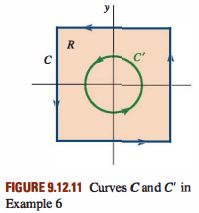Question 9.12.6: Evaluate the line integral in Example 4....
Evaluate the line integral in Example 4.
Learn more on how do we answer questions.
One method of evaluating the line integral is to write
\oint_{C} = \int_{C_{1}}+\int_{C_{2}}+\int_{C_{3}}+\int_{C_{4}}
and then evaluate the four integrals on the line segments C_{1}, C_{2}, C_{3}, and C_{4}. Alternatively, if we note that the circle C^{\prime}: x^{2}+y^{2} = 1 lies entirely within C (see FIGURE 9.12.11), then from Example 5 it is apparent that P = -y /\left(x^{2}+y^{2}\right) and Q = x /\left(x^{2}+y^{2}\right) have continuous first partial derivatives in the region R bounded between C and C^{\prime}. Moreover,
\frac{\partial P}{\partial y} = \frac{y^{2}-x^{2}}{\left(x^{2}+y^{2}\right)^{2}} = \frac{\partial Q}{\partial x}
in R. Hence, it follows from (5) that
\oint_{C} \frac{-y}{x^{2}+y^{2}} d x+\frac{x}{x^{2}+y^{2}} d y = \oint_{C^{\prime}} \frac{-y}{x^{2}+y^{2}} d x+\frac{x}{x^{2}+y^{2}} d y .
Using the parameterization x = \cos t, y = \sin t, 0 \leq t \leq 2 \pi for C^{\prime} we obtain
\begin{aligned} \oint_{C} \frac{-y}{x^{2}+y^{2}} d x+\frac{x}{x^{2}+y^{2}} d y = & \int_{0}^{2 \pi}[-\sin t(-\sin t)+\cos t(\cos t)] d t \\ &= \int_{0}^{2 \pi}\left(\sin ^{2} t+\cos ^{2} t\right) d t & (6) \\ & =\int_{0}^{2 \pi} d t = 2 \pi . \end{aligned}
